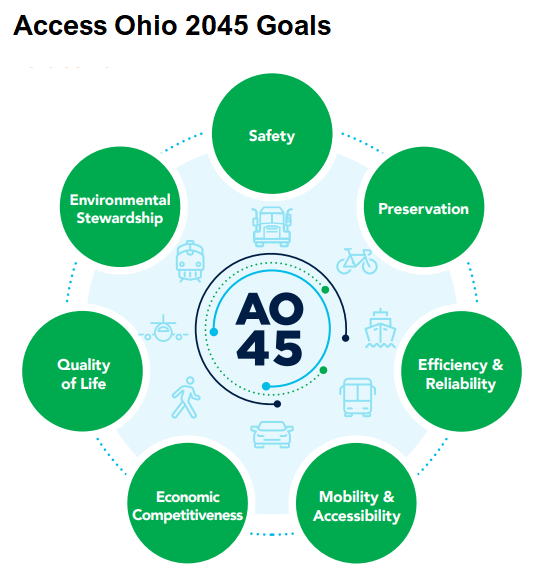Last week, the Ohio Department of Transportation (ODOT) released its long-range statewide transportation plan Access Ohio 2045 (AO45). Based on input from the public and subject matter experts (including Greater Ohio Policy Center), AO45 forms the basis for Ohio’s multimodal transportation investment policy plan for the next 25 years.
AO45 is a plan for all of Ohio, providing a vision for all partners involved in the planning and managing the state’s transportation system. The plan envisions a comprehensive, multimodal transportation system that has been developed using a scenario planning approach that considers a number of alternative futures for Ohio over the next quarter century.
Image Source: ODOT
Within the context of these scenarios are seven goals with 15 objectives that have been outlined for ODOT to meet over the next 25 years.
Image Source: ODOT
There are a number of aspects to the AO45 plan which GOPC advocated for as part of the process and which we are happy to see a part of the long-range plan. These include:
Asset Management: Maintain transportation assets in a “state of good repair”. ODOT states that it currently allocates 93% of its annual budget to “taking care of what it already has.” During the 2019 state transportation budget deliberations, ODOT Director Marchbanks committed to continuing to focus on preservation, not expansion, something that will be even more important in the short term in response to the COVID-19 pandemic as the state experiences motor fuel tax revenue declines resulting from statewide stay-at-home orders.
Broadband: Make highway right-of-way assets available to help close broadband and cellular infrastructure gaps. In yet another example of a problem that has been exacerbated by the COVID-19 pandemic, there are major areas of the state where broadband access to lacking or practically non-existent. This is a problem not only in rural Ohio, but even in some urban areas in the state. Permitting access to public rights-of-way to expand technology will have long-term benefits for the whole state.
Corridor Plans: Develop multimodal corridor plans that engage a comprehensive set of stakeholders and consider transportation land use, economic and technology assets. GOPC has recently written about the opportunities present through corridor concepts planning at the local level, and investment in these types of development strategies regionally and statewide can have the same benefits.
Economic Development: Identify and promote locations for economic development with good transportation access and compatible land uses. Focusing on areas with established transportation access makes sense both in terms of cost (not expanding already built-out systems) but ensuring workers have ready access to jobs and the state is able to compete economically into the future.
Increase Access to Public Transit: Among the strategies outlined as part of the report is increasing opportunities for local investments in transit through ODOT funding programs, coordinate services by partnering with the Ohio Public Transit Association (OPTA) and local operators to support coordinated plans and streamlined operations, and to advance Mobility as a Service (MaaS), including first- and last-mile connections.
Transit Funding: Among the major initiatives outlined by AO45 is a commitment for Ohio to research, pilot, and implement innovative approaches to funding transit capital and operating costs, as well as other multimodal and shared mobility solutions.
Advance walking & bicycling: AO45 makes a strong commitment towards active transportation, including strengthening statewide, regional, local and corridor pedestrian and bicycle planning, and educating the public at large on walking and biking issues.
In addition to identifying goals and objectives, AO45 quantifies what the cost of achieving these goals are, based on the various alternative futures. Between 2018 (when the AO45 planning process began) and 2045, AO45 estimates that ODOT will need to spend between $2.6-$2.8 Billion annually to address statewide transportation needs, while partners, including counties, municipalities, townships, and other state agencies, as well as public and private operators, will need to invest $3.7-$4.1 billion annually over the same time period.
Image Source: ODOT
You can access the full report online or tune-in tomorrow on Twitter as our first #GOPCThread of 2021 will focus on the various aspects of the AO45 plan.






